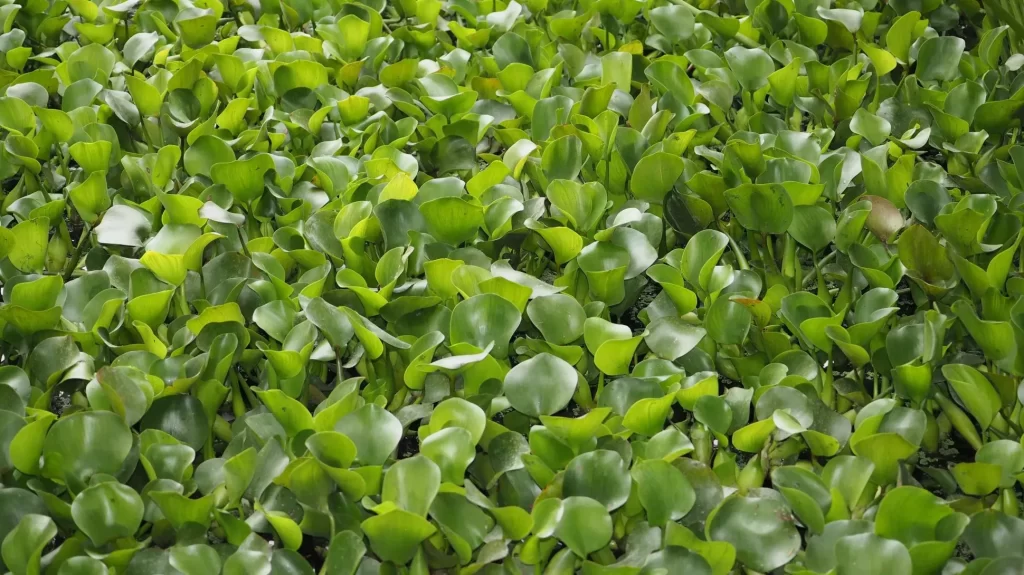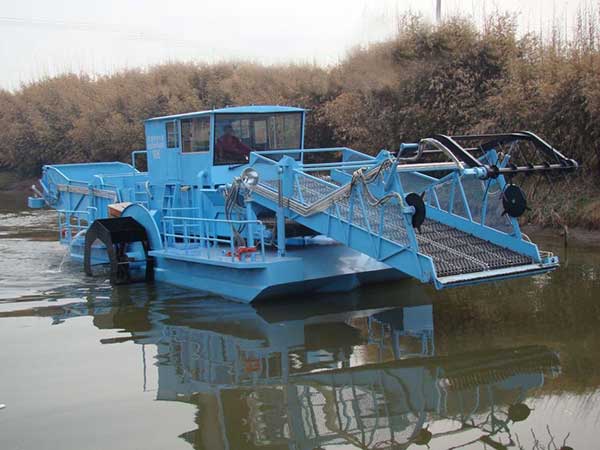Water hyacinth (Eichhornia crassipes), a native aquatic plant from South America, has rapidly spread worldwide in recent years, especially in tropical and subtropical regions. Because of its fast growth and reproduction rate, it is seen as an invasive species, bringing serious threats to aquatic ecosystems. Water hyacinth can block waterways, disrupt fishing activities, and lead to oxygen depletion in water, damaging the habitats of aquatic life. So, as an environmental or agricultural worker, you might face the challenge of effectively removing water hyacinth to protect water ecosystems. However, with so many types of water hyacinth harvesters on the market, how can you find the one that best suits your needs?
When choosing a water hyacinth harvester, it’s essential to consider several factors, like operating efficiency, equipment type, and maintenance costs. The wrong choice can affect your results, waste resources, and delay operations. Therefore, by clarifying your needs, understanding the features of different machines, and knowing how to evaluate them, you’ll be able to make a smart decision.
Next, I’ll offer practical tips and steps to help you select the right water hyacinth harvester. Through in-depth analysis of market options and a clear focus on user needs, I’ll guide you toward finding the most suitable solution in this complex decision-making process.

Contents
- 1 Characteristics and Impact of Water Hyacinth
- 2 How Does a Water Hyacinth Harvester Work?
- 3 Types of Water Hyacinth Harvesters
- 4 What Factors Should You Consider When Choosing a Water Hyacinth Harvester?
- 5 What Is the Price Range of a Water Hyacinth Harvester?
- 6 Maintenance and Care Requirements for a Water Hyacinth Harvester
- 7 How to Improve the Efficiency of Water Hyacinth Removal
- 8 Does a Water Hyacinth Harvester Meet Environmental Standards?
- 9 Is Renting a Water Hyacinth Harvester a Feasible Option?
- 10 What Are the Future Market Trends?
- 11 Conclusion
- 12 Why Choose Minnuo Water Hyacinth Harvester?
Characteristics and Impact of Water Hyacinth
Water hyacinth is a buoyant, perennial herbaceous plant that reproduces quickly, forming dense floating clusters. Its main characteristics include:
- Rapid Reproduction: Water hyacinth spreads fast through asexual reproduction. Under ideal conditions, a single plant can produce hundreds of offspring in just a few weeks.
- High Nutrient Demand: Water hyacinth grows rapidly and requires a large amount of nutrients. In nutrient-rich waters, its growth rate is even higher.
- Ecological Impact: The dense growth of water hyacinth blocks sunlight, reducing photosynthesis in the water and lowering dissolved oxygen levels. This directly affects the survival of fish and other aquatic organisms.
- Economic Losses: The overgrowth of water hyacinth disrupts navigation routes, irrigation, and aquaculture, leading to significant economic losses in agriculture and fisheries.
How Does a Water Hyacinth Harvester Work?
The working principle of a water hyacinth harvester mainly depends on its mechanical structure. The machine usually includes specialized cutting blades and a collection system:
- Cutting Mechanism: The harvester’s blades cut water hyacinth at specific speeds and angles, quickly damaging the plant’s root system and preventing regrowth.
- Collection System: After cutting, the harvester moves the water hyacinth onto a conveyor belt or another mechanism, transferring it onto the boat or transport vehicle for easy disposal.
With this efficient process, the harvester can clear large amounts of water hyacinth in a short time, greatly improving operational efficiency.
Types of Water Hyacinth Harvesters

Water hyacinth harvesters come in several main types:
- Pontoon Harvester: This harvester floats on the water’s surface, making it ideal for large open water areas. It offers high efficiency and can quickly clear water hyacinth, which is perfect for large-scale management projects.
- Towed Harvester: Boats tow this type of harvester, which makes it suitable for deep-water operations. It can work in more complex water environments and provides flexibility, though it requires a higher level of operational skill.
- Manual Harvester: This harvester works well for small bodies of water or targeted areas. Although it has lower efficiency, it requires a smaller investment, making it a good choice for small-scale projects.
- Multi-Function Harvester: Some modern water hyacinth harvesters come with additional features, such as water quality monitoring and sediment removal. These functions allow one machine to complete multiple tasks, improving overall efficiency.
What Factors Should You Consider When Choosing a Water Hyacinth Harvester?
When selecting the right water hyacinth harvester, consider these key factors:
- Operational Efficiency: Check the machine’s processing capacity, such as the amount of water hyacinth it can clear per hour. This helps ensure that it can complete the work within the required timeframe.
- Suitable Water Conditions: Different types of harvesters work best in different water depths, flow rates, and environmental conditions. Choose a machine that matches the specific characteristics of your waterway.
- Maintenance Costs: Understand the machine’s maintenance needs, including how often you’ll need to replace parts and the associated costs. This will help manage long-term expenses.
- Ease of Operation: Assess whether the machine is easy to operate and whether staff can quickly learn to use it. Simple operation can directly boost work efficiency.
- Environmental Friendliness: Choose a harvester designed to minimize secondary pollution, ensuring that the operation does not harm the ecosystem during use.
What Is the Price Range of a Water Hyacinth Harvester?
The price of a water hyacinth harvester varies based on brand, model, and features:
- Manual Harvester: Typically costs between a few thousand to tens of thousands of yuan, making it suitable for smaller water bodies and targeted areas.
- Pontoon and Towed Harvesters: These usually range from tens of thousands to over a hundred thousand yuan, depending on specific configurations and capabilities.
- Multi-Function Harvester: Prices can reach several hundred thousand yuan due to the advanced technology and additional features they offer.
Maintenance and Care Requirements for a Water Hyacinth Harvester
Proper maintenance and care can extend the lifespan of a water hyacinth harvester. Here are several key aspects to focus on:
- Regular Inspections: Follow the manufacturer’s recommendations to inspect the equipment regularly, especially the blades, engine, and hydraulic system. This helps identify any issues early on.
- Oil and Filter Replacements: Change the engine oil, hydraulic oil, and air filters on a regular schedule. This keeps the machine running at peak performance.
- Cleaning After Each Use: Clean the harvester thoroughly after every use to prevent weeds and debris from accumulating, which can otherwise impact efficiency.
- Maintenance Log: Keep a detailed log of each maintenance activity, including the date and specifics. This makes it easier to track service needs and manage upkeep over time.
How to Improve the Efficiency of Water Hyacinth Removal
Here are several tips to boost the efficiency of water hyacinth removal:
- Plan Operations Carefully: Create a detailed operation plan that includes the best times for work and optimal weather conditions. This helps maximize efficiency.
- Choose the Right Equipment: Select a harvester that matches the specific work environment to ensure it performs at its best.
- Train the Team: Provide professional training for operators to improve their handling skills and safety awareness, which leads to smoother and safer operations.
- Analyze Data: Record data from each operation, such as the amount cleared and time taken, and use this information to continuously refine and optimize the process.
Does a Water Hyacinth Harvester Meet Environmental Standards?
When purchasing a water hyacinth harvester, make sure the equipment meets local environmental standards. Key environmental considerations include:
- Secondary Pollution: Check if the harvester might cause any additional pollution to the water during operation. Look for products with a strong record of environmental responsibility.
- Noise Control: Ensure that the noise produced during operation complies with regulations. Whenever possible, choose equipment with a low-noise design to minimize disturbance.
Is Renting a Water Hyacinth Harvester a Feasible Option?
Renting a water hyacinth harvester can be a flexible choice, especially for short-term projects. The advantages of renting include:
- Reduced Initial Investment: Renting avoids a large upfront cost, making it suitable for smaller projects with limited budgets.
- Flexible Usage: Adjust equipment use based on project needs, which helps reduce idle time and optimize resources.
When renting, keep the following in mind:
- Rental Terms: Clearly understand the rental period, fees, and responsibilities to protect both parties’ interests.
- Equipment Condition: Inspect the equipment’s condition before renting to ensure it operates without issues.
- Rental Company’s Reputation: Choose a well-regarded rental company with reliable service for a smoother experience.
What Are the Future Market Trends?
As environmental awareness grows, the demand for water hyacinth harvesters is expected to continue rising. Key future trends include:
- Smart Technology: More water hyacinth harvesters will come equipped with intelligent control systems to monitor water quality and operational efficiency in real time.
- Multi-Function Integration: Equipment will increasingly combine multiple functions, such as water quality monitoring and ecological assessment, to enhance overall management capabilities.
- Policy Support: Government policies supporting water body management will drive the development and adoption of related equipment, encouraging innovation in this field.
Conclusion
A water hyacinth harvester is an effective tool for managing invasive water hyacinth, and choosing the right equipment can not only improve removal efficiency but also reduce long-term maintenance costs. With the analysis above, I hope you now have a clearer understanding of how to make decisions based on your specific needs and can find the most suitable harvester in the market to support the restoration and protection of water ecosystems.
Why Choose Minnuo Water Hyacinth Harvester?
When it comes to controlling water hyacinth, selecting the right harvester is essential. Minnuo water hyacinth harvesters offer multiple advantages, making them a trusted choice for many users. With strong cutting and collection capabilities, Minuo harvesters can quickly clear large amounts of water hyacinth, saving you both time and effort.
Whether you are working in small or large water bodies, we provide a range of models to suit your specific needs. Built with durable materials, our harvesters can withstand various environments, reducing the frequency of maintenance and ensuring stable, long-term performance. The design is straightforward, with a user-friendly interface that allows even beginners to operate the equipment easily, minimizing training time.Additionally, we offer comprehensive after-sales support to make sure you receive timely assistance during use, solving any issues that may arise.
Choosing a Minuo water hyacinth harvester means you gain an efficient and reliable tool for water management, helping to keep water bodies clean and protect the environment.

